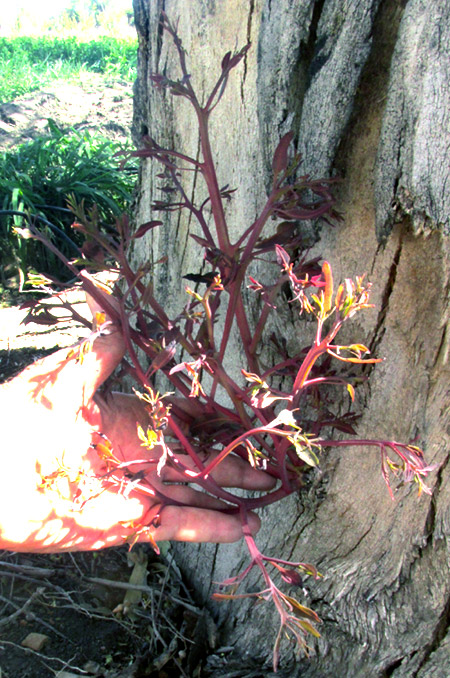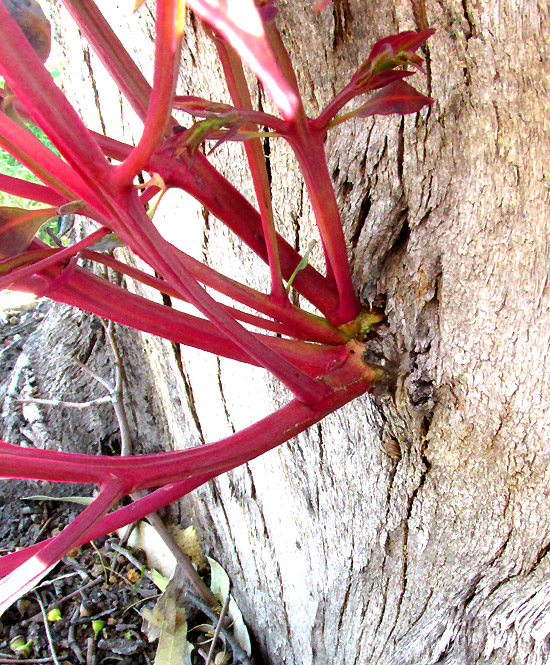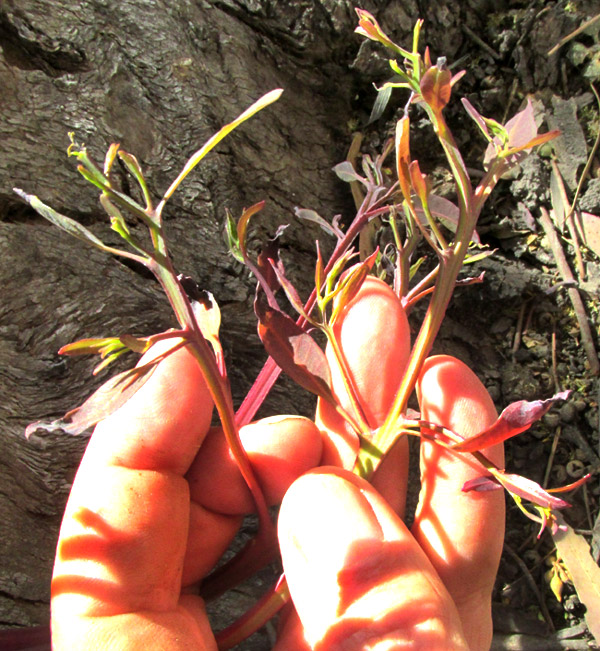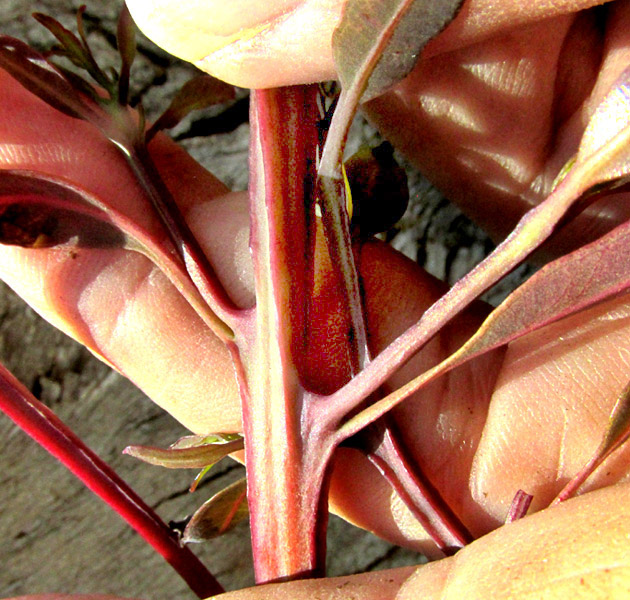Excerpts from Jim Conrad's
Naturalist Newsletter
Entry dated March 28, 2024, issued from near Tequisquiapan; elevation about 1,900m, (6200 ft), ~N20.57°, ~W99.89°; Querétaro state, MÉXICO
WITCH'S BROOM ON WILLOW TRUNK
 On a much damaged but living willow tree, the witch's broom at the right issued directly from the trunk's sapwood where a large part of the bark had been knocked off by a machine. At first I wondered if the witch's broom might be a kind of mistletoe, but no parasitic flowering plant species occurring in this area came close to looking like this. If it's not one of those, there's not much left looking like our subject, except witch's brooms, which can assume many forms.
On a much damaged but living willow tree, the witch's broom at the right issued directly from the trunk's sapwood where a large part of the bark had been knocked off by a machine. At first I wondered if the witch's broom might be a kind of mistletoe, but no parasitic flowering plant species occurring in this area came close to looking like this. If it's not one of those, there's not much left looking like our subject, except witch's brooms, which can assume many forms.
Witch's brooms can be caused by various agents, including fungi, insects, mites, nematodes, viruses, the fungus-like microorganisms known as oomycetes, and bacteria without cell walls and which parasitize the interiors of the host's cells, known as phytoplasmas. I'm guessing that our witch's broom is caused by a phytoplasma, because at university and government websites I find pictures of more or less similar witch's brooms infecting willows. These phytoplasma-caused witch's brooms are identified as caused by an unspecified species of Candidatus phytoplasma.

The manner by which phytoplasma organisms cause witch's brooms could explain the appearance of this particular individual. Phytoplasma-caused witch's brooms consist of the host's plant parts deformed in various ways. The host in this case was a Bonpland's Willow whose leaves, as on the witch's broom, appear singly at each stem nod, display a similar shape, and the witch's broom's color exactly matches the pinkish hue of the Bonpland's Willow's young stems, only more intense. Finally, it's to be noted that some of the witch's broom's leaves are green, indicating the presence of chlorophyll, which at least confirms that the broom is a photosynthesizing plant, not a fungus or flowering non-photosynthesizing plant such as the Indian Pipe.

However, one feature unlike that of a deformed willow stem is that the witch's broom's stems are somewhat flattened, while the willow's stems are rounded. Our witch's broom's stems are better seen below:

Above, note that the main stem as seen from our perspective is wider below and at the top than in the middle; it's somewhat flattened in certain parts. In the 2022 study by Xueting Wang and others entitled "Comparative Biochemical and Transcriptomic Analyses Provide New Insights into Phytoplasma Infection Responses in Cucumber," it's said that flat stems are typical symptoms of phytoplasma infections.
The genome sizes of phytoplasma organisms are extremely small, supposedly because of reductive evolution -- gene loss during evolution. The genome causing a Bermuda Grass phytoplasma disease bears one of the smallest known genomes of all living organisms. This gene loss may affect the appearance of the witch's broom. For example, phytoplasmas often hinder or destroy the cells' ability to produce chlorophyll, which could explain why our witch's broom displays so little greenness amid its vivid pinkish.
An interesting feature of the witch's broom seen above is that instead of arising from its host tree's bark, it issued directly from the sapwood where the bark and cambium layer had been knocked off. In the 2023 study by Drew Peltier and others entitled "Old reserves and ancient buds fuel regrowth of coast redwood after catastrophic fire," it was found that, after Coast Redwoods had been burnt during uncontrolled forest fires, new sprouts "... emerged from ancient buds—dormant under bark for centuries." They provided an image of a redwood log cut so that the "bud trace" was clearly visible growing through more than 150 rings -- one ring usually produced per year -- as sapwood grew around the ancient bud on the young tree. This shows how new sprouts can arise where bark and cambium have been destroyed.